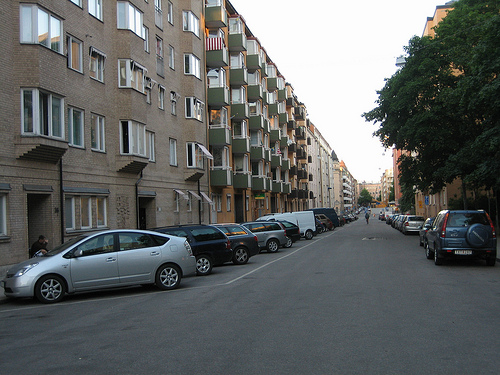How smart parking in Stockholm works
The fifth happiest nation in the world, according to Columbia University’s Earth Institute, also boasts a capital that has been steadily seeking to implement smart parking meters and policies. It’s not clear whether those efforts contribute to the overall happiness of Stockholm’s residents and visitors, but it’s worth examining what policies and programs the city has in place.

Congestion fees and high parking prices means only 8% of trips in Stockholm’s city center are taken by car. By Eurist e.V.
Stockholm’s parking regulations, first established in the 1970s when the baseline level of car ownership in the city was determined, have required revision due to the capital’s gentrification in recent decades. The influx of residents owns more cars: about 370 cars per 1,000 people citywide, with that figure lowering to 300 cars per 1,000 people in the inner city. Cars dominate the transit mode in the capital at 44 percent, but that figure drops to an impressive 8 percent in the city center, where parking prices are highest.
The high prices are principally due to congestion pricing, which Stockholm piloted in 2006 and officially implemented in 2007. The system has been a great success, lowering traffic by 18 percent and waiting times to enter the city center down by 50 percent. Public transportation has also seen a 4.5 percent increase in ridership, traffic has dropped by 20 percent, and carbon emissions have dropped by 14 to 18 percent.
As with London’s congestion-pricing scheme, electric vehicles (EVs) and motorcycles can park for free, as can those with disabled parking permit badges and construction tractors. In 2010, the city featured four on-street charging stations and 150 off-street. More have since been installed, though only about twenty-five EVs were registered in the city in 2010.
Analysts have criticized the city’s policies toward EVs or those with low emissions. Their number doesn’t seem to warrant the public investment made on their behalf, and so-called “clean vehicles” still require parking infrastructure at the expense of other land-use alternatives.
Still, the changes wrought by congestion pricing can’t be dismissed and are supported by other initiatives. In 2001, for example, Stockholm replaced spot-by-spot parking spaces, which were demarcated by painted white-stripe boxes, with multi-space pay-and-display smart parking machines installed to replace individual parking meters. Not only did the city no longer have to repaint the white lines every winter, more vehicles could fit along the curb. Stockholm also measured about 450 of its 1,200 block to determine the number of cars that would fit; in total, its inner city parking supply stands at roughly 32,000.
More recently, IBM and KTH Royal Institute of Technology has been gathering information on the city’s traffic flow by outfitting 1,500 taxis with GPS devices. The move allows city managers and residents to access real-time information on travel times and best commuting options.
Related Posts
Category: Parking Tech, Regulations





















